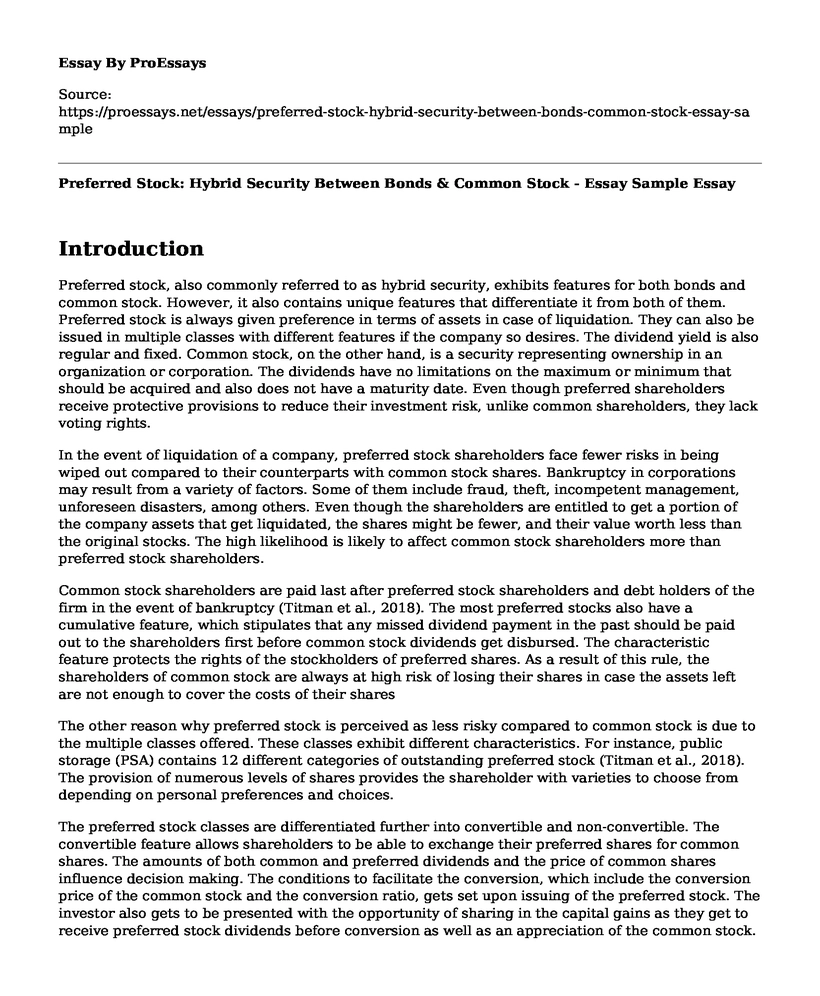Introduction
Preferred stock, also commonly referred to as hybrid security, exhibits features for both bonds and common stock. However, it also contains unique features that differentiate it from both of them. Preferred stock is always given preference in terms of assets in case of liquidation. They can also be issued in multiple classes with different features if the company so desires. The dividend yield is also regular and fixed. Common stock, on the other hand, is a security representing ownership in an organization or corporation. The dividends have no limitations on the maximum or minimum that should be acquired and also does not have a maturity date. Even though preferred shareholders receive protective provisions to reduce their investment risk, unlike common shareholders, they lack voting rights.
In the event of liquidation of a company, preferred stock shareholders face fewer risks in being wiped out compared to their counterparts with common stock shares. Bankruptcy in corporations may result from a variety of factors. Some of them include fraud, theft, incompetent management, unforeseen disasters, among others. Even though the shareholders are entitled to get a portion of the company assets that get liquidated, the shares might be fewer, and their value worth less than the original stocks. The high likelihood is likely to affect common stock shareholders more than preferred stock shareholders.
Common stock shareholders are paid last after preferred stock shareholders and debt holders of the firm in the event of bankruptcy (Titman et al., 2018). The most preferred stocks also have a cumulative feature, which stipulates that any missed dividend payment in the past should be paid out to the shareholders first before common stock dividends get disbursed. The characteristic feature protects the rights of the stockholders of preferred shares. As a result of this rule, the shareholders of common stock are always at high risk of losing their shares in case the assets left are not enough to cover the costs of their shares
The other reason why preferred stock is perceived as less risky compared to common stock is due to the multiple classes offered. These classes exhibit different characteristics. For instance, public storage (PSA) contains 12 different categories of outstanding preferred stock (Titman et al., 2018). The provision of numerous levels of shares provides the shareholder with varieties to choose from depending on personal preferences and choices.
The preferred stock classes are differentiated further into convertible and non-convertible. The convertible feature allows shareholders to be able to exchange their preferred shares for common shares. The amounts of both common and preferred dividends and the price of common shares influence decision making. The conditions to facilitate the conversion, which include the conversion price of the common stock and the conversion ratio, gets set upon issuing of the preferred stock. The investor also gets to be presented with the opportunity of sharing in the capital gains as they get to receive preferred stock dividends before conversion as well as an appreciation of the common stock.
Conclusion
In conclusion, Even though preferred shareholders receive protective provisions to reduce their investment risk, unlike common shareholders, they lack voting rights. Preferred dividends also get paid before standard bonuses, and when liquidation occurs, they are paid first before common shareholders. Preferred stock also provides provision for multiple classes, which provides the stakeholders with different varieties to choose from depending on their preferences. As a result of these characteristics, the preferred stock gets viewed as less risky than common stock.
References
Titman, S., Keown, A. J., & Martin, J. D. (2018). Financial management: Principles and applications. New York, NY: Pearson.
Cite this page
Preferred Stock: Hybrid Security Between Bonds & Common Stock - Essay Sample. (2023, May 02). Retrieved from https://proessays.net/essays/preferred-stock-hybrid-security-between-bonds-common-stock-essay-sample
If you are the original author of this essay and no longer wish to have it published on the ProEssays website, please click below to request its removal:
- Financial Statement Analysis Essay
- Motivational Factors in Banking - Essay Sample
- Calculating Return on Security Investment (ROSI) - Essay Sample
- Funding Sports/Festivals: Economic Impact and Misapplication - Research Paper
- Essay on Affordable Health Insurance Marketplaces: Government Policies for Managing Healthcare
- Paper Sample on Islamic Investment: Linking Religion & Secular Practices
- Research Paper Example on Healthcare Financing: An Overview of U.S. Systems & Networks







